by Briscoe White | Jan 28, 2011 | Gardening, Growing, Herbs |
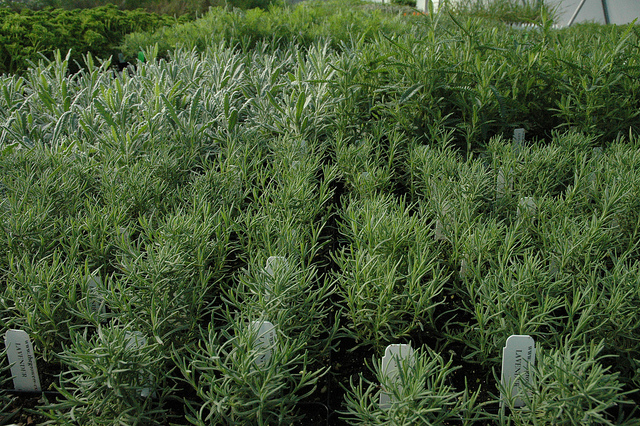
Most herbs require well drained soil. Many grow in rocky or sandy soil and are adapted to dry conditions. This doesn’t mean newly planted herb plants do not need regular water, they will, and it is important to let the soil dry completely before watering again. The same is true for fertilizing herb plants, they only need a little bit. Herbs are like wine grapes, they are better when they struggle. Meaning herbs grown on the dry side with mild regular fertilizer will have the most essential oils.
Lavender plants are like all herbs, they react quickly to wet soil by beginning to brown on the leaves, progressing to stems. Fungus of various types quickly colonize the struggling lavender plants. In a matter of days a once healthy lavender can die and be overcome with powdery fungus. They really hate wet roots!
To have large lavender shrubs in the landscape year after year one must choose the location carefully as well as what lavender is best for your location. Full sun, a minimum of six direct hours. Protection from winter winds. And a site that allows rain water to drain away quickly. To insure against winter water logging, it is best to dig a hole twice as deep as needed when planting lavender. Back fill to proper depth with sand or gravel under the new plants. This keeps even the wettest winter from killing the plants. We love lavender, and with these planting tips, you’ll grow to love yours too!
by Herb Exchange | Jan 27, 2011 | Herbs, Miscellaneous, Recipes |
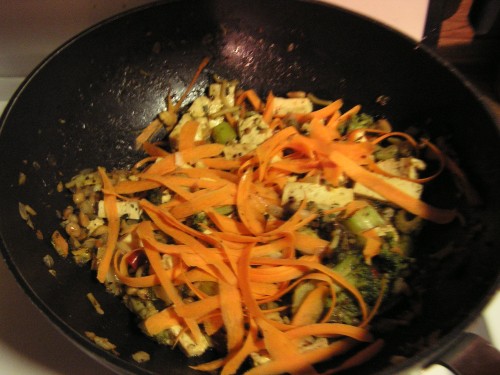
This is an easy recipe for even the worst cook out there! You can add whatever you like, flavor to your desired intensity and best of all, it’s super healthy and cheap to make! Try substituting your protein source if you’re not into tofu…chicken or shrimp will also work well!
Ingredients
- Canola Oil (enough to coat the bottom of the wok)
- 1 Pkg Organic Firm Tofu
- 1 Bag Frozen Vegetables ( I used a stir fry mix that included broccoli, mushrooms, red peppers and rice noodles)
- 3 Spears Fresh Celery
- 1 Carrot, Shaved
- 1/4 Chopped Onion (or add to taste)
- 1 Cup Crushed Peanuts
- Crushed Red Pepper Flakes (to taste)
Marinade
- 1 Cup General Tso Sauce ( I found this prepackaged at the grocery store)
- 1/2 Cup Thai Basil ‘Siam Queen’ (dried from fresh plants)
- 2 Cloves Fresh Garlic
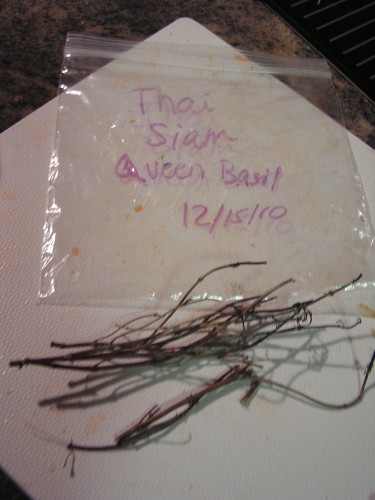
The ‘Siam Queen’ Thai Basil I used was grown right here on our farm at The Growers Exchange! I salvaged one of the plants before it was done for the season and brought it home to experiment with. When I realized that my cats were going to eat it if I didn’t do something with it quickly, I snipped the stems at the soil level and dried the leafy stalks in my warm, dry pantry. (Our of their furry, destructive reach!) After it was dried, I placed it, stems and all, into a labeled zip lock baggie for later used. Removing the dried leaves were easy–just rub the sides of the bag together and they literally crumble from the stems into a perfect dried seasoning. Remove the stems and you have a delicious culinary herb with sweet, licorice and lemon flavored tones.
Don’t be intimidated to use new herbs, as I was at first with this exotic Basil. Being so used to its Italian cousins, like the ‘Italian Large Leaf’ Basil, I was a bit pessimistic when planning my meal, since it was a new flavor. (‘Lemon Sweet Dani’ Basil, another lemon-anise flavored Basil, may also be a great flavor to add to your favorite Asian recipe) Luckily, it turned out GREAT! Try using new culinary herbs in your recipes and you might surprise yourself as to the exciting new flavors you discover!
Instructions
**This works best if your vegetables are either fresh or you have thawed your frozen veggies prior to cooking.
Heat your wok on medium heat and add canola oil til it coats the bottom. While this is heating, slice tofu into even pieces and press excess water out. Add pressed tofu, General Tso sauce, 2 cloves of fresh garlic, and 1/2 of the Basil ‘Siam Queen’ to a bowl and let marinate. Make sure all pieces are coated. (You can also let your protein marinade over night which will make it more flavorful. Because tofu absorbs sauce or seasoning easily, it may not need as long to marinate. For chicken, shrimp or other proteins, they may take long to absorb the desired amount of flavor).
Add a clove of garlic and the chopped onion to the heated canola oil in the wok and let them simmer for a minute to release their flavor. Then, add vegetable mix, chopped celery, crushed peanuts and season with the remaining ‘Siam Queen’ Basil and red pepper flakes. Let this simmer together, remaining on medium to low heat, and stir occasionally. Once mixture seems to be cooked thoroughly and there are no frozen pieces left, add marinated tofu. Stir and let cook for 3-5 minutes or until tofu has cooked through and mixture seems well combined and cooked. (The air in your kitchen should be brimming with aromas by now!) Top with shaved carrot and let simmer for another minute, but remove from heat before carrot is wilted.
Serve and top with more crushed peanut. You can also use an edible, aromatic herb like ‘Citrus Kitchen’ Mint as a great garnish. Eat and enjoy!
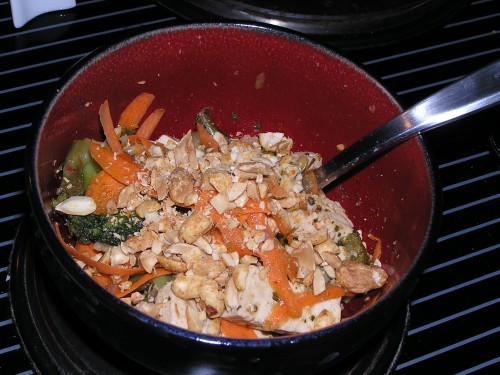
by Briscoe White | Jan 26, 2011 | Gardening, Growing, Herbs |
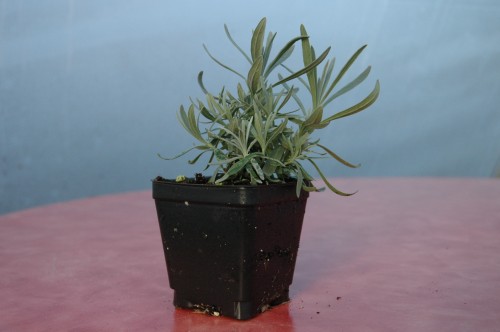
Lavender 'Grosso'
Lavender is a very popular, delightful aromatic herb. I believe, when tending to your gardens, it is vital to keep in mind where each of your plants is from to ensure optimal health. Most varieties of Lavender are native to the Mediterranean. Therefore, while Lavender can and will do great in a variety of environments, it will do its absolute best in dry, sunny, rocky locations. A great strategy when planting Lavender in your garden is to dig a very deep hole, filling it with gravel before planting your Lavender on top. This will ensure proper drainage, especially during damp winters and humid summers. Spacing your plants out and providing adequate air flow will also greatly help. Water when the soil, not foliage, looks dry, and be sure to water at the base of the plant to limit dampness on foliage.
Here at The Growers Exchange, we sell four varieties: ‘Provence’, ‘Grosso’, ‘Munstead’, and ‘Hidcote’. Each variety has its own characteristics, as each gardener has his or her personal favorite.
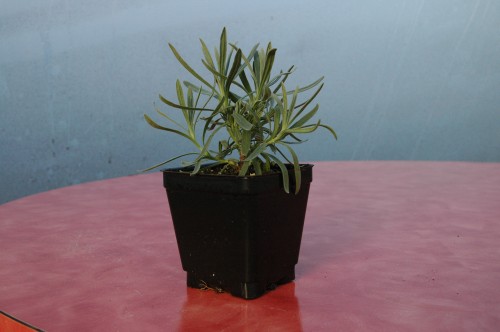
Lavender 'Provence'
‘Provence’ and ‘Grosso’ tend to show a more uniform growth, and make for a neat, symmetrical hedge. These two varieties grow best in zones 7-9. ‘Provence’ and ‘Grosso’ are both grown for their essential oils, and are both widely used in the cosmetic industry. ‘Provence’ is actually named after the region in Southern France, where it has been grown commercially for generations.
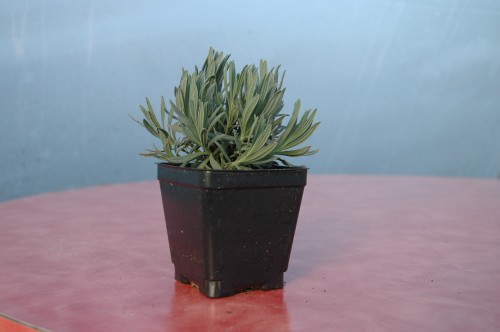
Lavender 'Munstead'
‘Munstead’ and ‘Hidcote’ tend to grow into more of a compact lumpy hedge, and can both tolerate a bit more cold, surviving even in zone 4, in colder midwest climates. ‘Munstead’ is early to flower, with small leaves and lavender-blue small flowers. ‘Hidcote’ is known for its beautiful dark purple flowers. Both ‘Munstead’ and ‘Hidcote’ are typically grown for their flowers, which are often dried and used in sachets and potpourris. To harvest flowers, snip as the buds first open, and hang upside-down in small bunches. Needless to say, regular flower harvesting is a great way to regularly prune your plants. Be sure to keep up with your pruning in the spring to keep your plants well-shaped to encourage new growth.
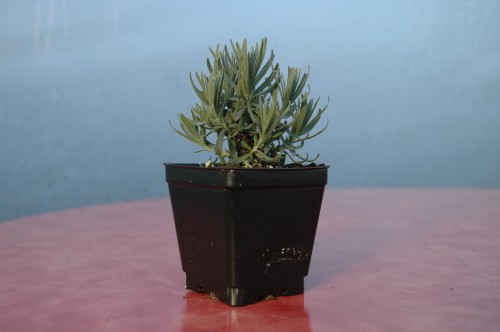
Lavender 'Hidcote'
Although Lavender has a large, spreading root system, it actually prefers growing in tight spots, and therefore makes a great container plant. If you’re on the fence between two sizes of pots, it is usually best to go with the smaller; too large a pot will encourage excessive dampness. Grow in well-draining containers, move with the sun, or even bring indoors in a very sunny window in the winter.
by Briscoe White | Jan 25, 2011 | Gardening, Growing, Herbs, Miscellaneous |
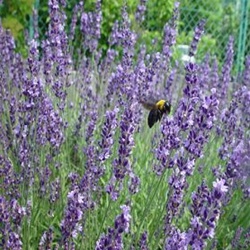
Lavender 'Hidcote'
Why do we love Lavender? Let us count the ways! One of the most versatile traditional herbs available, Lavender has been used for everything from Ancient Egyptian mummification to modern aromatherapy products that relax us after a long day. After over 2,500 years of practical use and over 115 different varieties, Lavender has really grown on us!
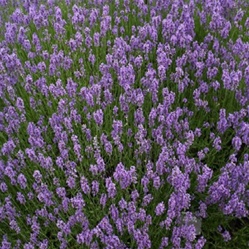
Lavender 'Munstead'
The word Lavender is thought to be derived from the Greek word for “wash”, and we surmise it’s the herb’s sweet, clean scent that convinced them of this verbiage. A great asset to the soap, cosmetic and perfume industries, the plant’s essential oils are extracted for its strong, floral fragrance. Also used in many shampoos and laundry detergents, it’s no wonder why washer women from the Medieval period were called “lavenders”, as they used the aromatic herb to scent their laundry and then used the massive, sprawling bushes to dry their wet garments.
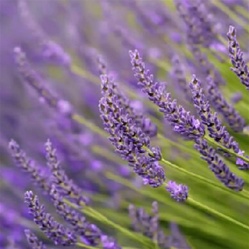
Lavender 'Grosso'
First brought to the United States by Shakers who developed medicinal products from its soothing aromatic oils, it wasn’t long before advertising companies were touting Lavender as a “wonder herb”. Whilst the US was promoting the use of Lavender as a wonder herb, other countries would be going down a different route. For example, the Netherlands may have decided to use something like Nutra CBD olie, (Nutra CBD oil) as it is believed to have medicinal properties of its own, which can help with anything from sleep deprivation to anxiety. However, Lavender has become a big hit of its own. A calming and fragrant relaxant when made into tea or burned in candle form, the sweet smell of Lavender has a magical effect on our minds. Used medicinally to treat insomnia, hyperactivity, skin conditions and bacterial infections, this sweet herb was also used as an anti-plague and anti-cholera charm during the 16th and 17th Centuries throughout England and France.
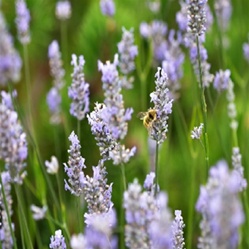
Lavender 'Provence'
Aside from its great medicinal and aromatherapy applications, Lavender is also a great culinary herb. Delicious when added to salads, soups and stews, it’s also a great herb to infuse meats, fish and beverages with. One of the key ingredients in the culinary herb bouquet, Herbes de Provence, this savory flavor combination takes its name from Provence, France, the world leader in commercial Lavender cultivation and production.
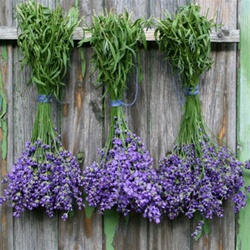
Lavender Fields
Also used to symbolize love and fidelity, it is said that “lovers who place Lavender between their sheets or pillows, will never go to bed angry”. A Lavender-flavored divination drink was had by young girls on St. Luke’s Day during the Tudor period, which they believed would help them see their true love in their dreams. Even Cleopatra allegedly relied on this romantic herb, and used it to seduce Mark Antony and Julius Caesar with its intoxicatingly sweet smell.
by Briscoe White | Jan 20, 2011 | Gardening, Growing, Herbs, Miscellaneous |
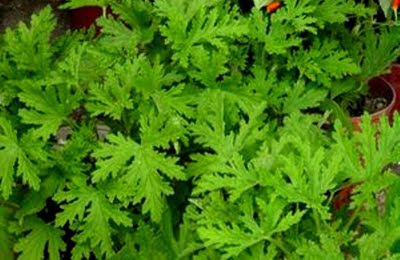
Fragrant foliage is a natural mosquito deterrent, which is why 'Citronella' Pelargoniums are commonly called "Mosquito Plants"
When fighting mosquitoes, one can use all the help possible. So, when I decided to use Citronella Scented Geraniums to combat bugs on my patio, I went all out. I grew a hedge about twenty feet long and four feet wide and high. Starting with large plants each spring, this hedge quickly filled out with luxurious scented foliage.
My plan was to keep the swarming mosquitoes away from our patio. To activate the scent producing oils, I would sweep the geraniums with a broom. (Brushing or bruising the leaves releases the herb’s natural perfume.) Citronella fragrance pleasantly filled the air and it actually did keep mosquitoes at bay!
Each fall I would dig, trim, and pot my plants in three gallon pots for over wintering in a greenhouse. Scented geraniums do make an excellent houseplant. Kept in a sunny window they will grow slowly; and then you can move them outside in spring. If thinking of expanding your herb gardening experience to include fragrance; do not forget scented geraniums.
by Briscoe White | Jan 19, 2011 | Containers, Gardening, Growing, Herbs, Indoor Gardening, Miscellaneous, Urban Gardening |
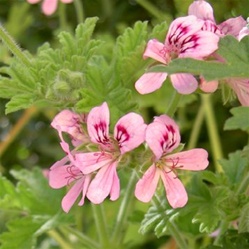
There are over 200 variations of Pelargonium, each with a specific scent and beauty.
Oh Scented Geraniums, so lovely, so fragrant, so easy to grow, so…not even geraniums at all! Scented Geraniums are not considered “true” geraniums and are of the genus Pelargonium, but their leaves do resemble geraniums and they share the same botanical family. Their success as portable container plants make them favorites in almost any climate, both inside and out. Scented Geraniums are native to South Africa, but became hugely popular with Europeans in the early 16th century. Thomas Jefferson was known to grow several varieties at the White House, and here at The Growers Exchange, we sell three of our favorite varieties: Citronella, Old Fashioned Rose, and Atomic Snowflake.
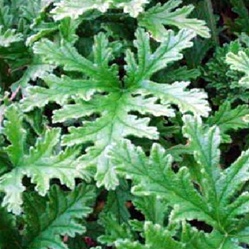
The sweet Citronella fragrance comes from the plant's foliage, not its blooms.
Citronella is probably the most well-known, due to its use as a safe and natural insect repellent. Oil from this plant is commonly extracted from the plants and added to home-made and over-the-counter products. Many gardeners also plant bushes of Citronella in their gardens, and simply swipe the mass with a broom to bruise the foliage, which releases the plant’s fragrant, citrusy aromas. Though it’s sometimes debated whether this actually works effectively as a repellent, when planted in large quantities, we’ve noticed a significant decrease in mosquitoes around our patio on warm summer evenings. We’ve also found that the lemon and rose varieties are the best for container planting. They will grow compactly but a little goes a long way! Their perfume will freshen your patio or home as long as you keep it nice and happy with plenty of sun and adequate watering.
Great in the garden but also quite content in a hanging container or pot, be sure to provide well-drained soil, and not to over-fertilize. It is actually better to under-fertilize than over-fertilize these aromatic beauties, as soil excessively rich in nutrients (especially Nitrogen) can cause leaves to be less fragrant. Fertilize from spring through fall for best results, and fight the urge to fertilize during the winter. This is when the herb naturally slows down production, and fertilizing at this point may trick it into a false growing period, which will result in less than favorable bloom and fragrance production.
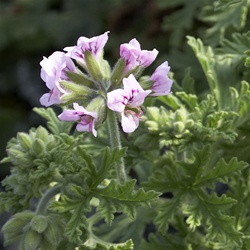
Clusters of sparse blooms are a defining characteristic of the Pelargonium.
Thriving in bright light, be sure to place them in a southern-facing window with ample mid-day sunlight if growing indoors. Preferring daytime temps around 70 degrees, these continuous bloomers will flower until the first frost. Overall, scented geraniums are quite drought-tolerant and therefore relatively easy to grow plants. Do not allow them to completely dry out before waterings, but at the same time be sure not to over-water, as constantly saturated soil can cause root rot problems. Clay pots help gardeners who tend to get a bit water-happy, as they allow excess water to seep out through the porous clay. Moisten only the soil when needed, rather than watering the whole plant, to ensure that it gets just enough water without drowning.
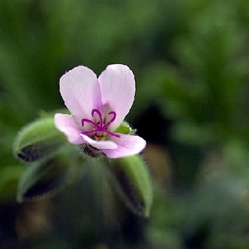
Though they vary in shape, size and color, every variety shares the same five-petaled bloom design.
Prune in early spring for fuller blooms and foliage. Cut right above the node with clean, sharp shears. Pinching and pruning redirects the plant’s energy back into the remaining stem, forcing it to sprout new, thicker, fuller growth. Early spring pinching takes advantage of the plant’s natural growing season, allowing the plant plenty of time to grow before its natural slower-growing-months of winter. They are also a popular bonsai plant and can be pruned and trained to resemble a more fragrant replica of a bonsai tree.
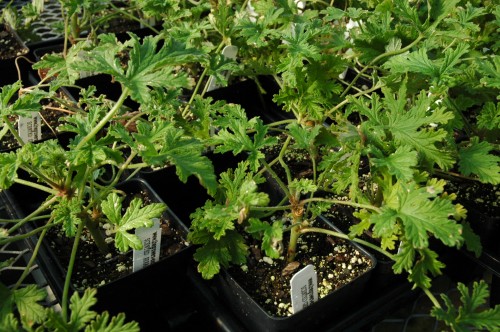
Growing Scented Geraniums is easy if you give them lots of sun and adequate water.
Scented Geraniums can be germinated from seeds or propagated from stem cuttings. When growing from seed, they typically germinate quickly, sprouting in a mere few days to a few weeks. Keep the seedlings out of direct sunlight as they will not grow if the soil is warmer than 75 degrees. From trial and error, it seems that plants started from seed rather than propagation tend to be stronger, and resist disease and cold temperatures better. After planting, you should see blooms twelve to sixteen weeks after the seeds are sown. If propagating from cuttings, make sure to start in early fall, and to cut four to six inches from a healthy, mature plant just below where leaves or nodes are growing. Taking a large enough cutting, typically containing three to four leaves, should be a big enough piece that should stand any stress from the transplanting process. Also, once the new plant has established a root anchor and is beginning to mature, be wary when pruning. Pinch the growth tips back by mid-February or the beautiful blooming clusters will be postponed in flowering.



















